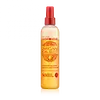What's inside
What's inside
 Key Ingredients
Key Ingredients

 Benefits
Benefits

 Concerns
Concerns

 Ingredients Side-by-side
Ingredients Side-by-side

Water
Skin ConditioningCyclopentasiloxane
EmollientDimethicone
EmollientAmodimethicone
Cetrimonium Chloride
AntimicrobialPropylene Glycol
HumectantOctylacrylamide/Acrylates/Butylaminoethyl Methacrylate Copolymer
Tocopherol
AntioxidantPanthenol
Skin ConditioningCamellia Oleifera Seed Oil
Skin ConditioningHydrolyzed Rice Protein
Skin ConditioningHydrogenated Grapeseed Oil
EmollientCitric Acid
BufferingDisodium EDTA-Copper
AstringentPhenoxyethanol
PreservativeParfum
MaskingWater, Cyclopentasiloxane, Dimethicone, Amodimethicone, Cetrimonium Chloride, Propylene Glycol, Octylacrylamide/Acrylates/Butylaminoethyl Methacrylate Copolymer, Tocopherol, Panthenol, Camellia Oleifera Seed Oil, Hydrolyzed Rice Protein, Hydrogenated Grapeseed Oil, Citric Acid, Disodium EDTA-Copper, Phenoxyethanol, Parfum
Water
Skin ConditioningCyclopentasiloxane
EmollientArgania Spinosa Kernel Oil
EmollientCocodimonium Hydroxypropyl Hydrolyzed Keratin
Skin ConditioningCocodimonium Hydroxypropyl Hydrolyzed Wheat Protein
CleansingHydrolyzed Wheat Protein Pg-Propyl Silanetriol
Skin ConditioningPanthenol
Skin ConditioningDimethicone
EmollientDimethiconol
EmollientDisiloxane
Skin ConditioningPolyquaternium-16
Polyquaternium-6
Gluconolactone
Skin ConditioningLactic Acid
BufferingPEG-12 Dimethicone
Skin ConditioningPhenyl Trimethicone
Skin ConditioningBenzophenone-4
UV AbsorberParfum
MaskingLinalool
PerfumingSodium Benzoate
MaskingCI 14700
Cosmetic ColorantCI 19140
Cosmetic ColorantWater, Cyclopentasiloxane, Argania Spinosa Kernel Oil, Cocodimonium Hydroxypropyl Hydrolyzed Keratin, Cocodimonium Hydroxypropyl Hydrolyzed Wheat Protein, Hydrolyzed Wheat Protein Pg-Propyl Silanetriol, Panthenol, Dimethicone, Dimethiconol, Disiloxane, Polyquaternium-16, Polyquaternium-6, Gluconolactone, Lactic Acid, PEG-12 Dimethicone, Phenyl Trimethicone, Benzophenone-4, Parfum, Linalool, Sodium Benzoate, CI 14700, CI 19140
 Reviews
Reviews

Ingredients Explained
These ingredients are found in both products.
Ingredients higher up in an ingredient list are typically present in a larger amount.
Cyclopentasiloxane, or D5, is a silicone used to improve texture of products and trap moisture.
D5 is considered lightweight and volatile. Volatile means it evaporates quickly after application. Once evaporated, D5 leaves a thin barrier that helps keep skin hydrated.
It is also an emollient. Emollients help soften the skin and prevent water loss. Silicones create a silky texture in products. D5 helps other ingredients become more spreadable.
Studies show D5 is safe to use in skincare products. We recommend speaking with a skincare professional if you have concerns.
Learn more about CyclopentasiloxaneDimethicone is a type of synthetic silicone created from natural materials such as quartz.
What it does:
Dimethicone comes in different viscosities:
Depending on the viscosity, dimethicone has different properties.
Ingredients lists don't always show which type is used, so we recommend reaching out to the brand if you have questions about the viscosity.
This ingredient is unlikely to cause irritation because it does not get absorbed into skin. However, people with silicone allergies should be careful about using this ingredient.
Note: Dimethicone may contribute to pilling. This is because it is not oil or water soluble, so pilling may occur when layered with products. When mixed with heavy oils in a formula, the outcome is also quite greasy.
Learn more about DimethiconePanthenol is a common ingredient that helps hydrate and soothe the skin. It is found naturally in our skin and hair.
There are two forms of panthenol: D and L.
D-panthenol is also known as dexpanthenol. Most cosmetics use dexpanthenol or a mixture of D and L-panthenol.
Panthenol is famous due to its ability to go deeper into the skin's layers. Using this ingredient has numerous pros (and no cons):
Like hyaluronic acid, panthenol is a humectant. Humectants are able to bind and hold large amounts of water to keep skin hydrated.
This ingredient works well for wound healing. It works by increasing tissue in the wound and helps close open wounds.
Once oxidized, panthenol converts to pantothenic acid. Panthothenic acid is found in all living cells.
This ingredient is also referred to as pro-vitamin B5.
Learn more about PanthenolParfum is a catch-all term for an ingredient or more that is used to give a scent to products.
Also called "fragrance", this ingredient can be a blend of hundreds of chemicals or plant oils. This means every product with "fragrance" or "parfum" in the ingredients list is a different mixture.
For instance, Habanolide is a proprietary trade name for a specific aroma chemical. When used as a fragrance ingredient in cosmetics, most aroma chemicals fall under the broad labeling category of “FRAGRANCE” or “PARFUM” according to EU and US regulations.
The term 'parfum' or 'fragrance' is not regulated in many countries. In many cases, it is up to the brand to define this term.
For instance, many brands choose to label themselves as "fragrance-free" because they are not using synthetic fragrances. However, their products may still contain ingredients such as essential oils that are considered a fragrance by INCI standards.
One example is Calendula flower extract. Calendula is an essential oil that still imparts a scent or 'fragrance'.
Depending on the blend, the ingredients in the mixture can cause allergies and sensitivities on the skin. Some ingredients that are known EU allergens include linalool and citronellol.
Parfum can also be used to mask or cover an unpleasant scent.
The bottom line is: not all fragrances/parfum/ingredients are created equally. If you are worried about fragrances, we recommend taking a closer look at an ingredient. And of course, we always recommend speaking with a professional.
Learn more about ParfumWater. It's the most common cosmetic ingredient of all. You'll usually see it at the top of ingredient lists, meaning that it makes up the largest part of the product.
So why is it so popular? Water most often acts as a solvent - this means that it helps dissolve other ingredients into the formulation.
You'll also recognize water as that liquid we all need to stay alive. If you see this, drink a glass of water. Stay hydrated!
Learn more about Water